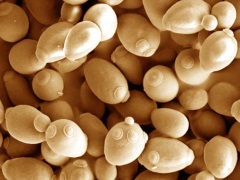Features
What’s in it for yeast?
Date: 2019-01-15 15:06:31.0
Author: Jon Evans

Yeast (Saccharomyces cerevisiae) cells.
Image: Mogana Das Murtey and Patchamuthu
Ramasamy.
Why do yeast (Saccharomyces cerevisiae) produce ethanol? It’s very handy for us that they do, but what do the yeast get out of it? Because fermenting glucose and other sugars into ethanol doesn’t generate as much energy for metabolism and growth as converting them into carbon dioxide via aerobic respiration, which yeast can also do.
“Metabolizing a six-carbon molecule [glucose] to a two-carbon molecule [ethanol], rather than to carbon dioxide, means part of the energy and matter stored in glucose is lost. It makes no sense,” says Matthias Heinemann, professor of molecular systems biology at the University of Groningen in the Netherlands. It’s almost as if yeast are producing ethanol purely as a favor to us.
But now Heinemann and two colleagues have found the real reason, and it turns out that ethanol production acts as a kind of ‘safety valve’ for yeast, switching on when the yeast cell is at risk of metabolic overload.
To uncover this reason, Heinemann and two colleagues developed a thermodynamic model of yeast metabolism that incorporated 241 metabolic processes and 156 metabolites. What made the model particularly novel, however, was that it was also designed to take account of the Gibbs energy dissipation in yeast cells, meaning the energy released by all the chemical reactions taking place in a cell.
The three scientists then used this model to analyze experimental data for yeast cells grown at various glucose concentrations, including data on growth rates, metabolite uptake and excretion rates. As they report in a paper in Nature Metabolism, the model’s predictions matched the experimental data fairly well, with the model accurately predicting that the yeast would metabolize glucose via respiration at low concentrations and then switch to fermentation at high glucose concentrations.
But what the model also revealed was that although the Gibbs energy dissipation initially increased in line with the rate of glucose consumption, as would be expected, it eventually plateaued. And it was exactly at this plateau point that the yeast switched from respiration to fermentation. This suggests that the switch occurs to prevent the yeast cell from running its metabolism at too high a rate, as fermentation produces less energy from glucose than respiration and so limits the energy available for metabolism.
Heinemann thinks that running its metabolism too high would damage the yeast cell. Probably not through overheating, as a small yeast cell can quickly lose heat, but rather because enzymes and biochemicals could potentially move about the yeast cell so quickly that they might damage important cellular structures and organelles.
What is more, it’s not just yeast that operates this safety valve. Heinemann and his colleagues produced a similar thermodynamic model for the model bacterium Escherichia coli, encompassing over 1000 metabolic processes and 626 metabolites, and found that it appears to operate in a similar way. An E. coli cell will metabolize glucose by respiration until the Gibbs energy dissipation reaches its maximum level, at which point it switches to producing acetate via fermentation.
“Yeast and E. coli live in completely different environments, yet have about the same dissipation limit that is even at about the same value. This suggests that this limit is something universal,” says Heinemann. Far from not making sense, it turns out that producing ethanol is a perfectly sensible strategy for yeast, as well as being very handy for us.
The views represented here are solely those of the author and do not necessarily represent those of John Wiley and Sons, Ltd. or of the SCI.
Displaying 2 keywords used to tag this article:
- Jules Audemars-Australia Best Quali
- DG6582 Mens Moncler Down Jackets Gr
